How to Master the Soft Sell [Techniques + Examples]
Casey O'Connor
Contents
- What is a Soft Sell?
- Soft Sell vs. Hard Sell
- The Advantages and Disadvantages of the Soft Sell Approach
- When to Choose the Soft Sell Approach (and When to Blend)
- How to Use the Soft Sell Technique
- Soft Sell Examples
- Tips for a Successful Soft Sell
- Leveraging Sales Technology to Master the Soft Sell
- Frequently Asked Questions About the Soft Sell Approach
Today’s B2B buyer has access to more information than ever before; in fact, most buyers have completed nearly 70% of their research before they ever make contact with sales.
This means that, by the time they do reach out to a sales rep, they have absolutely no interest in being sold to.
In response to this shift in power in the sales process, sales reps have needed to adjust their approach and tactics to maintain some leverage and offer value.
One way that savvy sales reps are keeping up with this need is by opting for a “soft sell” approach rather than the more traditional (read: pushier) hard sell.
In this article, we’ll go over everything you need to know about the soft sell, including what exactly it looks like, how it differs from traditional sales, how to use it in the sales process, and a few examples.
Here’s what we’ll cover:
- What Is a Soft Sell?
- Soft Sell vs. Hard Sell
- The Advantages and Disadvantages of the Soft Sell Approach
- When to Choose the Soft Sell Approach (and When to Blend)
- How to Use the Soft Sell Technique
- Soft Sell Examples
- Tips for a Successful Soft Sell
- Leveraging Sales Technology to Master the Soft Sell
- FAQs
What is a Soft Sell?
A “soft sell” is a subtle sales approach that prioritizes productive, value-driven buyer/seller relationships over closing deals.
Before we go further into the concept of soft selling, it’s important to note that the approach is not mutually exclusive with closing deals quickly. Although many buyers prefer soft selling because they feel less pressure to buy, that doesn’t mean they aren’t also eager and interested to find a solution to their problem. They just aren’t interested in aggressive sales tactics or false urgency.
Similarly, sellers don’t need to be deferential, either. Soft selling is not the same thing as passive selling, and the approach shouldn’t be confused with meekness, insecurity, or lack of assertion. Plenty of soft-selling sales reps close deals more quickly than their peers who take a more traditional approach.
With that being said, sales reps who practice soft selling generally take the time necessary to build a trusting relationship with the buyer at hand. They spend as much of the sales cycle as they need building rapport and establishing themselves as trusted advisors through easy, personable conversation. This is why the soft sell process generally moves more slowly than a hard sell approach.
It’s through this easy, low-pressure conversation that soft-selling sales reps learn more about the prospect’s unique pain points, challenges, and solution needs.

Soft selling is an especially important skill for sales reps who sell SaaS or other subscription products where a long-lasting, mutually profitable relationship is the basis of the sale.
Soft Sell vs. Hard Sell
The landscape of sales has undergone a significant transformation, moving away from aggressive, short-sighted tactics towards approaches that prioritize long-term customer relationships. Understanding the fundamental differences between “soft sell” and “hard sell” is crucial for any sales professional looking to thrive in this new environment.
The goal of a hard sell is a fast close; the goal of a soft sell is a solid relationship that will eventually lead to a sale. 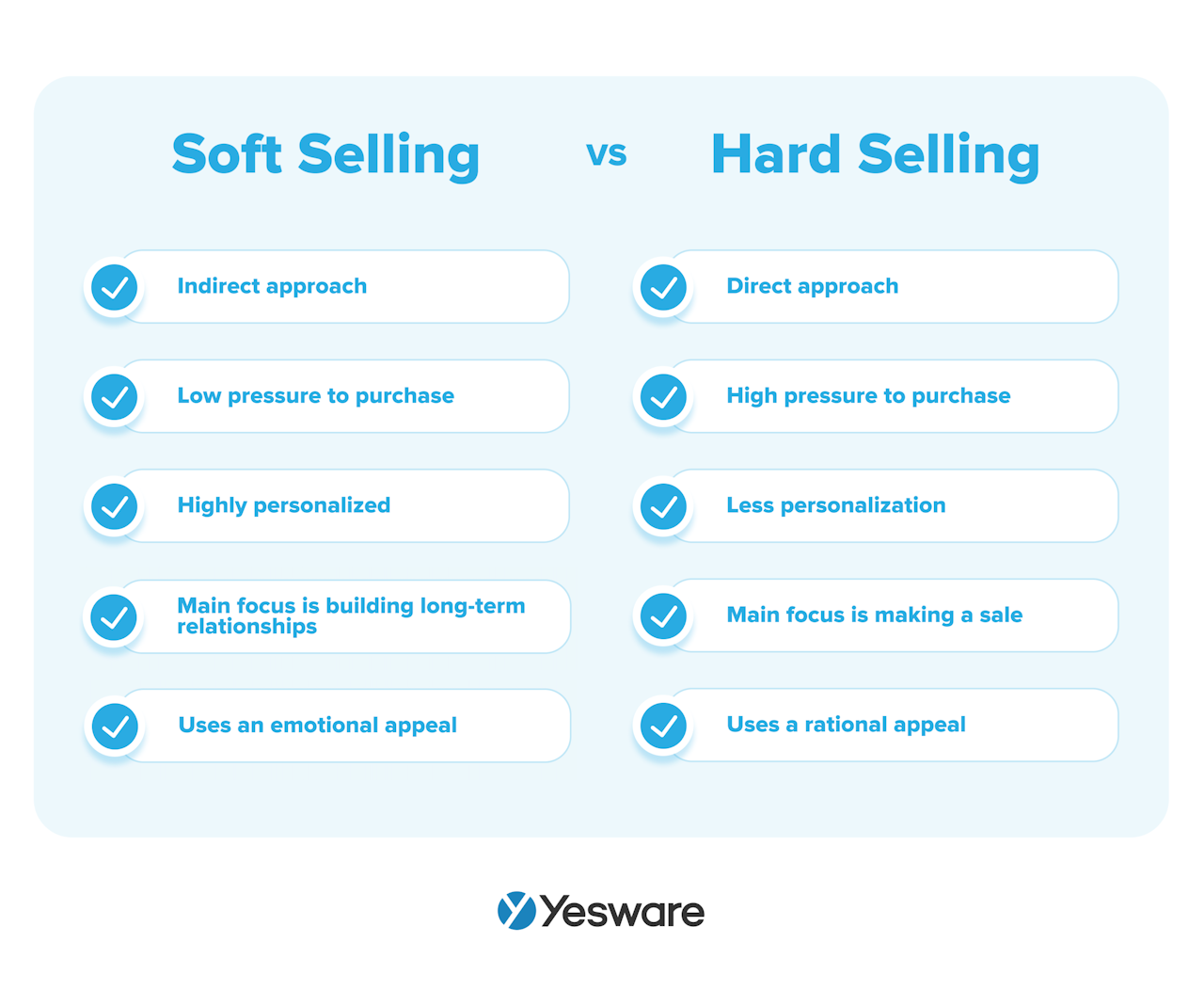
The Hard Sell: High Pressure, Quick Wins
The hard sell is a direct, assertive, and often aggressive sales technique focused on closing a deal as quickly as possible. Its hallmarks include:
- High Pressure: Creating a sense of urgency, scarcity, or fear of missing out.
- Feature-Focused: Emphasizing product features and specifications rather than deep customer needs.
- Direct Language: Using strong, definitive statements and pushing for an immediate decision.
- Objection Overcoming: Viewing objections as hurdles to be overcome through persuasion or counterarguments.
- Transactional Focus: Primarily concerned with the single sale, often at the expense of long-term customer relationships.
While a hard sell can sometimes secure a quick win, it often alienates prospects, leads to buyer’s remorse, and typically results in one-time purchases rather than fostering customer loyalty.
The Soft Sell: Building Value, Nurturing Relationships
In stark contrast, the soft sell is a subtle, empathetic, and low-pressure sales approach that prioritizes building genuine relationships and delivering value. Key characteristics include:
- Low Pressure: Creating a relaxed, comfortable environment for the prospect to explore their options by using the right sales tonality.
- Customer-Centric: Focusing the sales pitch deeply on understanding the prospect’s unique needs, challenges, and goals.
- Consultative & Educational: Acting as a trusted advisor, providing relevant information and insights without immediately pushing a product.
- Active Listening: Prioritizing understanding the prospect over speaking or pitching.
- Relationship-Focused: Aiming to build long-term rapport, trust, and mutual benefit, recognizing that sales may unfold over time.
The soft sell aims to inform and empower the customer, allowing them space to make a decision at their own pace, fostering a sense of partnership rather than a confrontation.
Why the Market Has Shifted: It’s a Necessity, Not Just a Preference
The move away from the hard sell isn’t just a trend; it’s a fundamental shift driven by changes in buyer behavior and market dynamics. For many businesses, particularly those in complex or high-value sectors, adopting a soft sell approach is no longer a preference but a necessity for survival and growth.
- The Informed Buyer: Today’s customers are empowered. Before even contacting a sales rep, they conduct extensive online research, read reviews, compare products, and often understand their own problems better than ever before. Aggressive tactics are immediately recognized and rejected by these well-informed buyers, who seek genuine collaboration, not coercion.
- Demand for Value and Trust: In a world saturated with choices, buyers prioritize trust and value. They want solutions that genuinely solve their problems and partners they can rely on, not just a product pushed by a persuasive pitch. A soft sell builds this essential foundation of trust.
- Complexity of Modern Solutions: Many of today’s products and services, especially in B2B markets (like software, financial services, or consulting), are complex, high-value investments. They require a thorough understanding, customization, and often involve multiple stakeholders. A hard sell simply doesn’t allow for the deep discovery, education, and consensus-building necessary for these intricate sales cycles.
- Focus on Long-Term Relationships and CLTV: Businesses are increasingly aware of the immense value of customer retention and Customer Lifetime Value (CLTV). A single, aggressive sale might boost short-term numbers, but it rarely leads to repeat business, upsells, or invaluable referrals. The soft sell, by cultivating strong relationships, is the engine of sustainable, long-term growth.
- Transparency and Social Proof: In the digital age, reputations are built on transparency and authenticity. Negative experiences from a hard sell can quickly spread through online reviews and social media, severely damaging a brand. A soft sell, conversely, fosters positive experiences that lead to positive word-of-mouth and a strong brand image.

In essence, the market has shifted because buyers demand it. Businesses that embrace the soft sell recognize that genuine connection, empathy, and a focus on lasting value are the most powerful drivers of sales success in the modern era.
Success Rates
Response rates in a study of hard sell vs. soft sell email reply rates were very telling.
Although the “hard sell” aggressive emails got a higher reply rate (1.9% vs. 1.1%), the replies were largely angry and aggressive. When the researchers looked more carefully, they found that the soft sell emails actually received overwhelmingly more positive responses than the hard sell ones (31% vs. 13%).
Further, the hard sell emails resulted in a 25% unsubscribe rate; the soft sell emails only saw a 10% departure.
One conclusion to draw from this data is that both approaches are being used and validated in the market — but only one (soft selling) is generating positive feedback from buyers.
The Advantages and Disadvantages of the Soft Sell Approach
While the soft sell approach has become increasingly vital in today’s customer-centric market, it’s important to understand that no sales methodology is without its trade-offs. A balanced perspective allows sales professionals to leverage its strengths effectively and mitigate its potential drawbacks.
Advantages (Pros) of the Soft Sell
The benefits of adopting a soft sell methodology are numerous and often lead to more sustainable, profitable growth:
- Builds Lasting Customer Relationships and Trust: By prioritizing understanding and empathy over immediate conversion, the soft sell naturally fosters genuine rapport and trust. Prospects are more likely to view you as a trusted advisor rather than just a salesperson.
- Increases Customer Loyalty and Retention: Customers who feel genuinely understood and valued are far more likely to remain loyal to your brand. The low-pressure environment of the soft sell reduces buyer’s remorse and builds a foundation for long-term partnerships.
- Higher Customer Lifetime Value (CLTV): Loyal, retained customers tend to purchase more over time, are more open to upsells and cross-sells, and often cost less to serve than acquiring new customers. The soft sell’s focus on relationships directly contributes to maximizing CLTV.
- Generates More Referrals and Organic Growth: Satisfied and trusting customers become advocates for your business. Positive word-of-mouth and referrals from highly loyal clients are invaluable for organic growth and often lead to higher-quality leads with shorter sales cycles.
- Creates a Positive Brand Image and Reduces Sales Pressure: A soft sell approach cultivates a reputation for being customer-focused, ethical, and helpful. This positive brand perception makes future sales efforts easier and contributes to an overall less stressful, more enjoyable experience for both buyer and seller.
- Better Suited for Complex Products/Services: For solutions that require significant investment, education, or customization, the soft sell’s emphasis on discovery, understanding, and patient consultation is far more effective than a hard, quick pitch. It allows time for the buyer to grasp complex value propositions and involves multiple stakeholders.
Disadvantages (Cons) of the Soft Sell
Despite its many benefits, the soft sell approach does present certain challenges that sales teams must be prepared to address:
- Time-Consuming: Requires Patience and a Longer Sales Cycle: Building genuine relationships and thoroughly understanding complex needs takes time. The soft sell is not designed for rapid, transactional closes, which can be a challenge for sales teams with aggressive short-term quotas.
- Requires High Skill Levels: The soft sell demands strong interpersonal skills, including exceptional active listening, deep empathy, insightful questioning, and the ability to articulate value without being overly pushy. Not all sales professionals naturally possess or are easily trained in these nuanced abilities.
- Risk of Passivity: Can Be Too Subtle: If not balanced with clear communication and appropriate guidance, a soft sell can sometimes be too subtle. Sales reps might fail to recognize buying signals or provide clear calls to action, potentially leading to missed opportunities or deals that stall indefinitely.
- Not Suitable for All Scenarios: The soft sell is less effective, or even inappropriate, for certain types of sales. For highly transactional, low-value, commodity products, or situations demanding immediate urgency (e.g., a limited-time flash sale), a more direct, efficient approach might be necessary to meet market expectations and buyer intent.
When to Choose the Soft Sell Approach (and When to Blend)
Understanding the advantages and disadvantages of the soft sell is key, but the ultimate strategic question is: When should you employ this approach, and when might a different tactic, or a blend, be more appropriate? The answer lies in aligning your sales methodology with the specific context of the buyer, the product, and the market.
Ideal Scenarios for the Soft Sell
The soft sell truly shines and demonstrates its superior effectiveness in situations where trust, expertise, and a deep understanding are paramount. Consider the soft sell as your go-to strategy in these contexts:
- Complex Products/Services Requiring Education: If your offering isn’t easily understood or requires significant explanation of its benefits and functionality, a soft sell allows you to educate the prospect patiently, answer questions thoroughly, and ensure they grasp the full value without feeling rushed. Think enterprise software, specialized consulting, or innovative new technologies.
- High-Value Deals with Significant Investment: When a product or service represents a substantial financial or operational commitment for the buyer, they need time, reassurance, and a sense of partnership. The soft sell fosters the trust required for such significant decisions, as opposed to pressuring them into a choice they might later regret.
- Long Sales Cycles: For sales processes that naturally span weeks or months, building a robust relationship is non-negotiable. The soft sell’s emphasis on consistent, valuable engagement ensures you remain a trusted advisor throughout the extended decision-making journey, outlasting competitors focused on quick wins.
- B2B Sales (Where Relationships Are Paramount): In business-to-business environments, decisions often involve multiple stakeholders, complex internal processes, and the potential for long-term partnerships. The soft sell helps navigate these complexities by establishing strong interpersonal bonds and understanding organizational dynamics.
- Building Brand Loyalty and a Strong Customer Base: If your primary goal is to cultivate a loyal customer base that will return for future purchases and advocate for your brand, the soft sell is invaluable. It focuses on creating a positive customer experience that extends far beyond the initial transaction.
- Situations Requiring Deep Understanding of Customer Pain Points: When the solution requires uncovering nuanced problems, unique challenges, or highly specific needs, the soft sell encourages open dialogue and detailed discovery, allowing you to tailor your offering precisely.
When a Harder Touch Might Be Justified (Briefly)
While the soft sell is generally preferable, there are rare, specific scenarios where a more direct or “harder” touch might be justifiable or even expected:
- Low-Cost, Commodity Products with High Urgency: For very simple, inexpensive items with clear, immediate benefits (e.g., a limited-time flash sale on a widely understood product), a more direct call to action focused on scarcity or urgency can be effective.
- Very Short Sales Cycles with Clear, Immediate Needs: If a prospect has a pre-defined, urgent need for a basic, standardized solution and is already primed to buy, a highly efficient, direct approach might be appropriate to meet their immediate demand.
It’s critical to note that even in these scenarios, a foundation of respect and transparency remains essential. An overly aggressive approach can still damage reputation and prevent repeat business.
The Art of Blending: Adapting as the Situation Progresses
The most skilled sales professionals rarely stick to one single approach exclusively. Instead, they master the art of blending—integrating elements from both soft and hard sell techniques, adapting their style as the situation progresses.
- You might begin with a soft, consultative approach during the initial discovery call to build rapport and uncover needs.
- As you gain a deeper understanding and present a solution, you might become more direct in articulating its specific benefits and return on investment.
- If an urgent, time-sensitive incentive arises, you might introduce elements of urgency (carefully and honestly) towards the close, such as with the help of a sales promotion, without abandoning the established trust.
- Even in a predominantly hard-sell scenario, incorporating active listening and empathy can soften the edges and improve the customer experience.
The key to blending successfully lies in acute situational awareness, strong emotional intelligence, and the flexibility to pivot your strategy to best serve the customer’s needs and buying stage. It’s about knowing when to lead with questions, when to educate, and when to confidently ask for the business, all within a framework of genuine value delivery.
How to Use the Soft Sell Technique
Soft selling is actually not terribly complex; in fact, it’s a skill that most people use regularly in their day-to-day life.
Any subtle persuasion you’ve tried — convincing a friend to try a new restaurant or talking your spouse into which Friday night movie to choose — is a form of soft selling.
Any salesperson can master this process; it’s simply a matter of knowing the routine. Here are the steps to follow if you want to use the soft sell technique in your sales process. 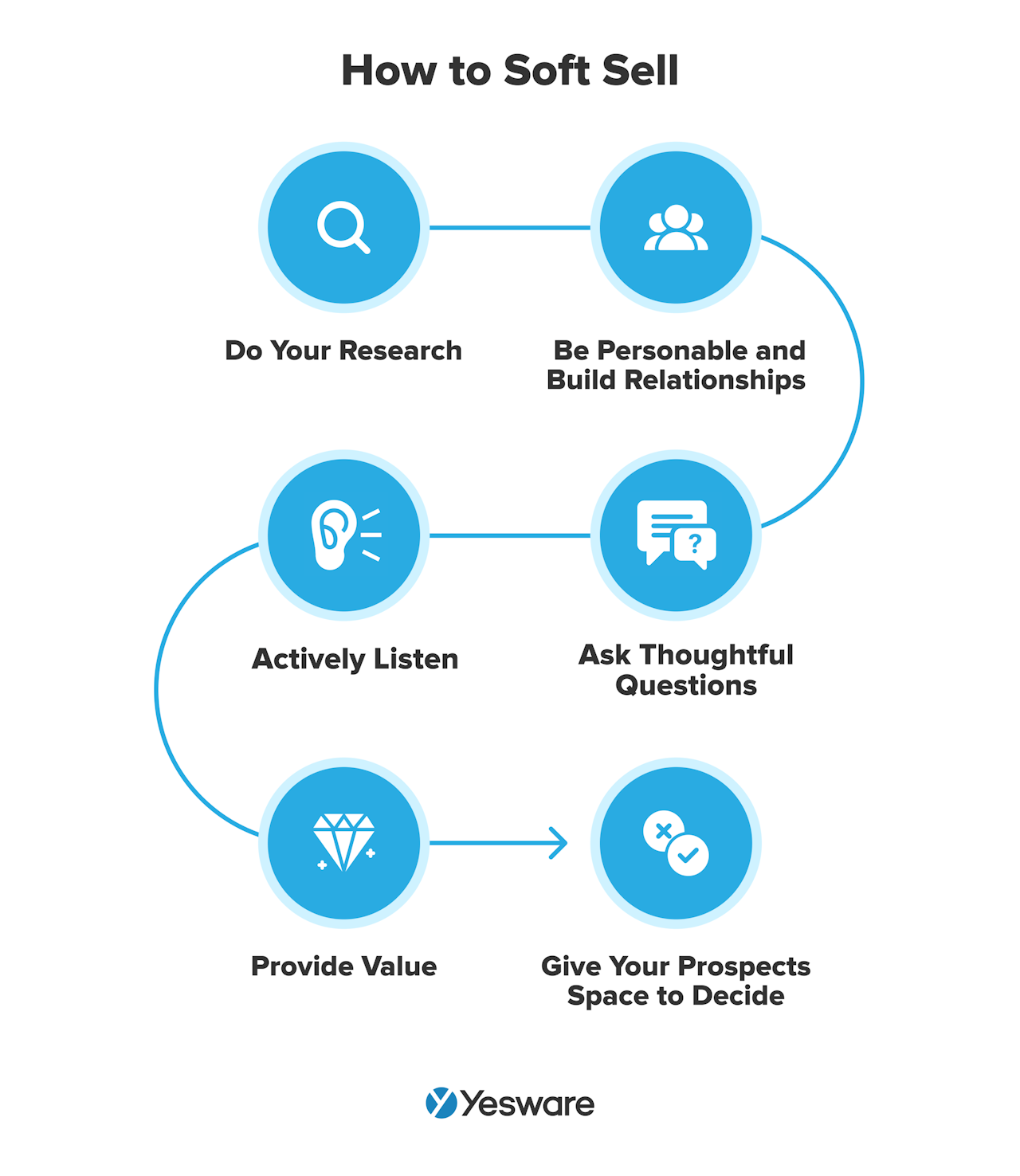
1. Do Your Research
The backbone of soft selling is great research.
Without detailed knowledge about the prospect’s company, challenges, and needs, soft selling is simply ineffective. In order for soft selling to work well, the sales rep needs to know the exact right questions to ask — and the right levers to push — to coax the buyer toward closing.
If you’re not sure where to start, begin by making sure your sales and marketing teams have aligned to create a detailed ideal customer profile (ICP) and buyer personas for each of your customer segments. 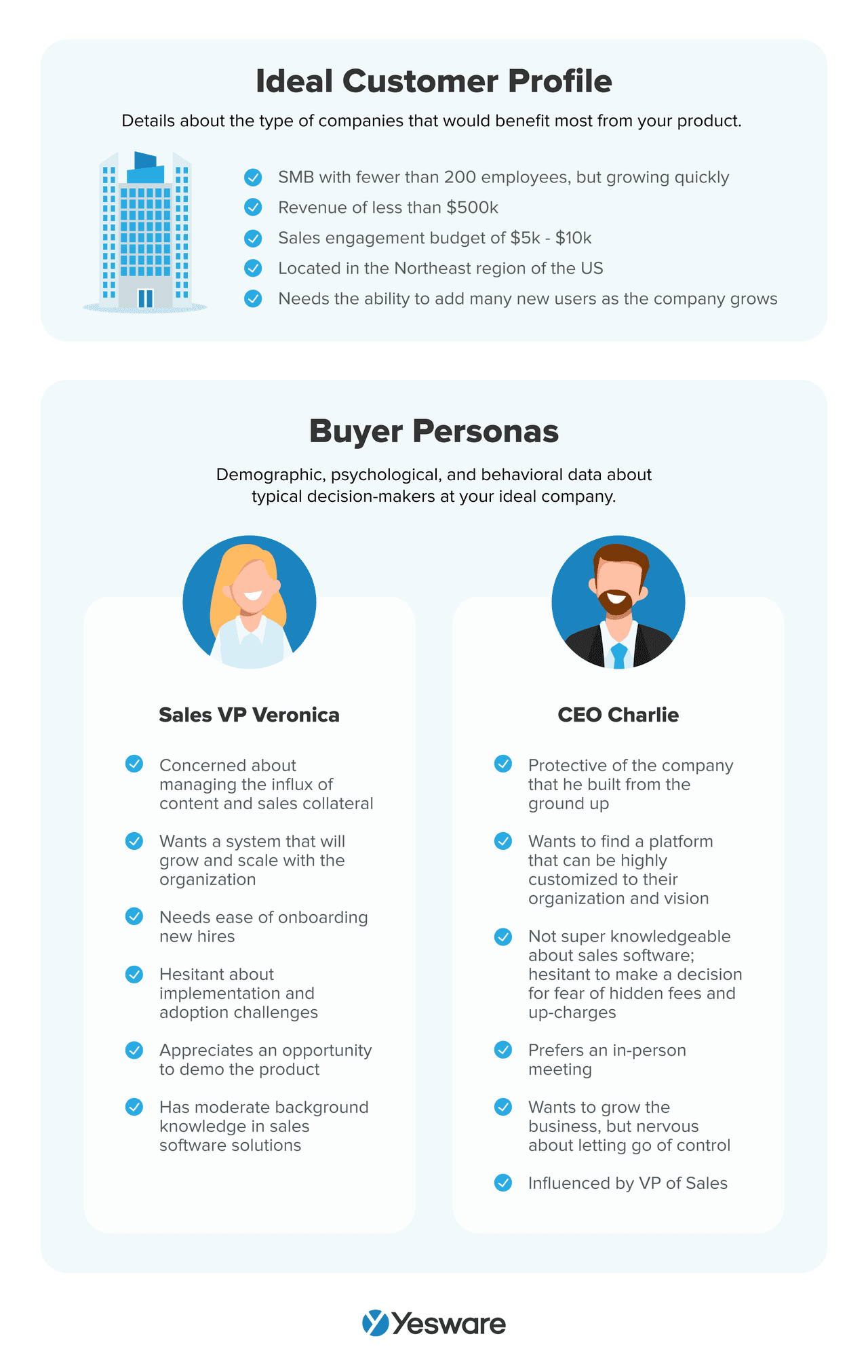
2. Be Personable and Build Relationships
Soft selling also requires sales reps to be friendly, approachable, and relatable.
Whatever you do, do not go into your sales meeting with even a hint of a discernible agenda. Avoid reading from a script; instead be casual and conversational, with the goal of creating a relationship and doing whatever you can to help the prospect solve the problem — even if it means pointing them in another direction.
Be empathetic, show genuine interest in them, and put their needs above the sale.
3. Ask Thoughtful Questions
Even if you’ve left no stone unturned in your research, it’s still critically important that sales reps take the time to ask strategic open-ended questions that help qualify prospects. 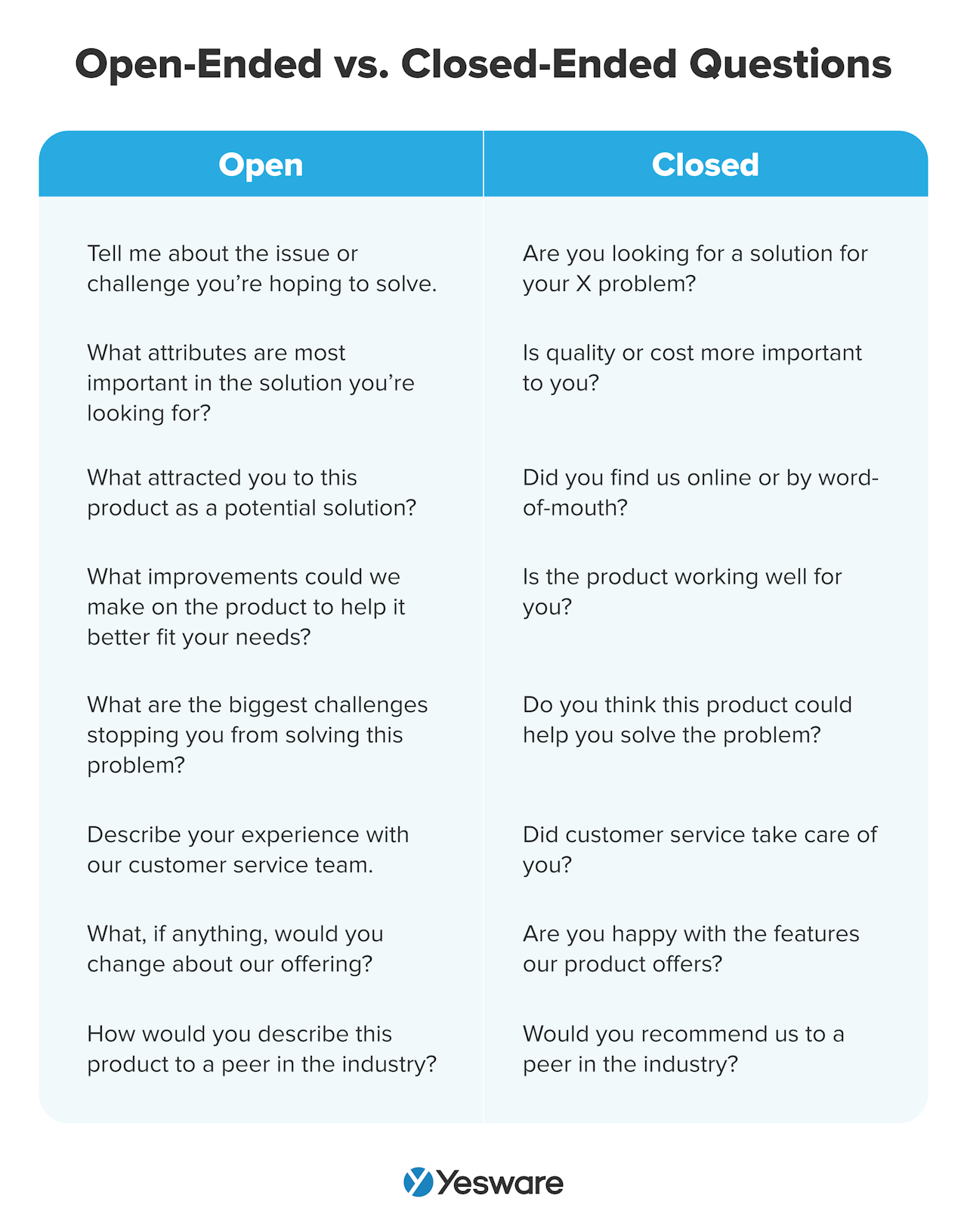 Ask these questions even if you think you know the answer from your research; sometimes hearing a prospect’s thoughts in their own words can help shed new insight into their needs.
Ask these questions even if you think you know the answer from your research; sometimes hearing a prospect’s thoughts in their own words can help shed new insight into their needs.
4. Actively Listen
Although not exclusive to soft selling, active listening is one of the most important aspects of this sales approach. 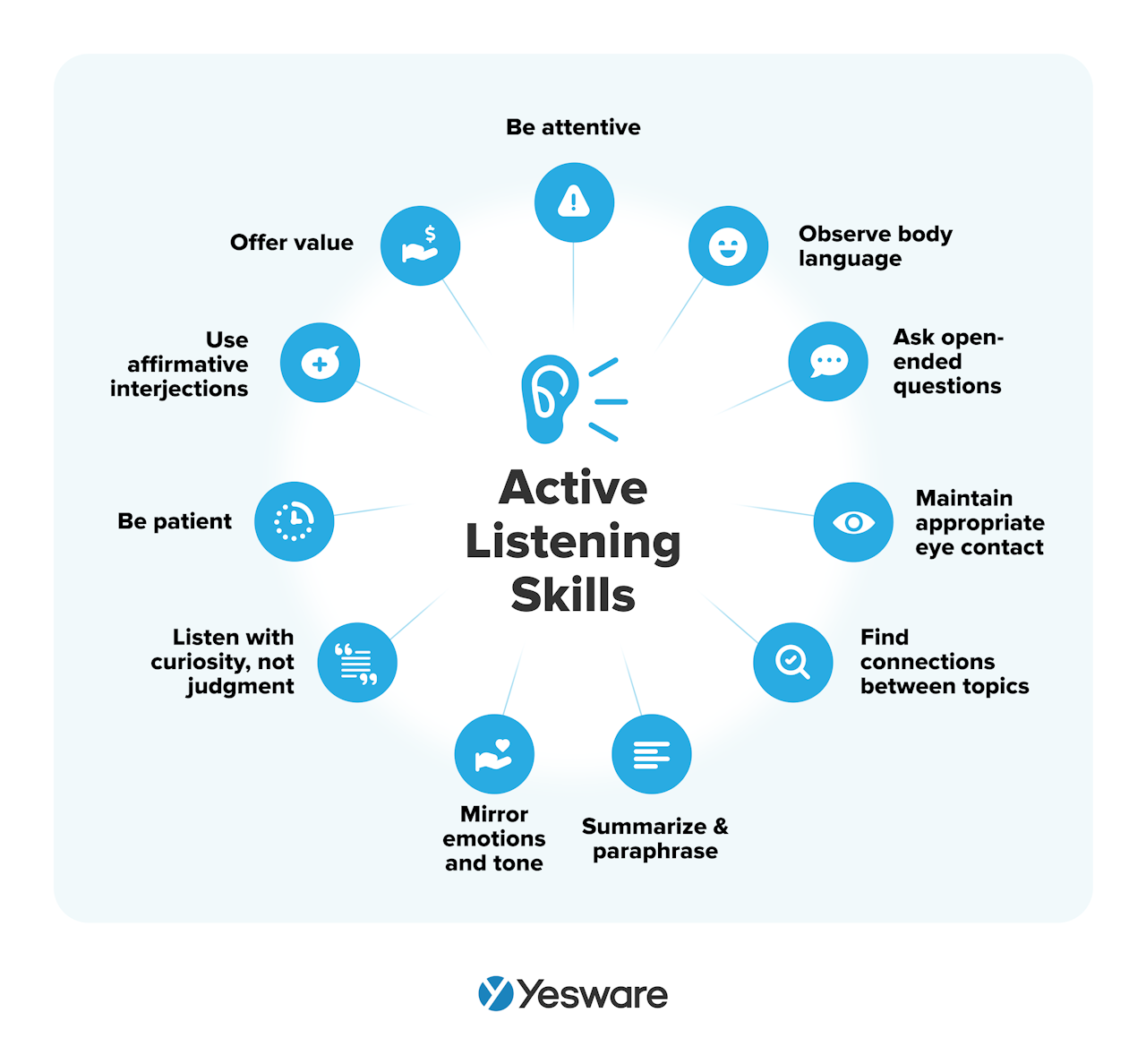 When sales reps actively listen, they are making an effort to hear the message behind what a prospect is communicating — not just the words. When prospects feel heard like this, it helps them feel valued and builds up your credibility in their eyes.
When sales reps actively listen, they are making an effort to hear the message behind what a prospect is communicating — not just the words. When prospects feel heard like this, it helps them feel valued and builds up your credibility in their eyes.
5. Provide Value (Without Asking for the Sale)
One of the hallmarks of an effective soft sell is that the process is value-driven, with no expectations from the seller.
In other words, soft-selling sales reps should strive to offer personalized guidance or feedback in every sales interaction, regardless of how likely the prospect seems to close at any given moment.
The goal is to deliver an exceptional experience, which will ultimately be part of what persuades them to buy.
6. Give Your Prospects Space to Decide
Once you’ve run through a soft sell process, it’s time to sit back and let the prospect take the lead. If you find yourself pressuring the prospect for an answer at any point, the “softness” is gone, so avoid making additional contact while they consider their options.
That being said, be sure to make yourself available to answer any lingering questions or concerns they may have.
The next time you’re trying to talk a friend or family member into something, see if you notice yourself following any of the steps in this process. Chances are good that you already have some practice in subtle persuasion, which can be easily applied to new sales scenarios.
Tip: Are your current sales techniques moving the needle? Grab our latest findings on sales outreach strategies and trends below.
 Sales Engagement Data Trends from 3+ Million Sales ActivitiesLooking at millions of tracked email activity over the past few years, this ebook is filled with our top studies and findings to help sales teams accelerate results.
Sales Engagement Data Trends from 3+ Million Sales ActivitiesLooking at millions of tracked email activity over the past few years, this ebook is filled with our top studies and findings to help sales teams accelerate results.
Soft Sell Examples
Here are a few examples of soft-sell examples from well-known brands.
1. Coca-Cola

Coca-Cola sure knows how to be relatable, opening their ad with a nod to “the good old days.” Notice how the campaign makes no mention of the ingredients (even though the ad references how the product is made), doesn’t push a price or promotion, and makes no false pretenses about low quality. There’s no push to buy here — but many people still want to go out and grab a Coke when they see it.
2. Clorox

Clorox also leaned way into relatability when they gave a nod to their germ-fighting sidekicks: moms. Not only is this a fun way to show social proof, but it’s also a down-to-earth way to prove the effectiveness of the product.
3. YETI

YETI is a brand well-known for their rugged insulated gear, and their Hungry Life YouTube series is a perfect example of the soft sell in action. They use incredible storytelling, videography, and imagery to sell their cooler, which is depicted but never mentioned. Doesn’t matter, though — despite the lack of a hard sell, it’s hard to watch Hungry Life and not want that cooler (and that dinner…and, well, the entire experience).
Tips for a Successful Soft Sell
Do Your Research
This is a standard part of any sales process, but it’s so important to soft selling that it’s worth mentioning again first: do your research. Soft selling will almost never stand up on its own as a sales strategy if the sales rep doesn’t know enough about the buyer to steer the conversation.
Plus, researching the prospect ahead of time shows that you’re committed and invested in their unique needs.
Build Positive Relationships
Soft selling revolves around the buyer/seller relationship — and it needs to be purely positive.
For the buyer, the sales rep should be a trusted advisor. Professionalism always counts, but soft selling also requires a certain approachability, and sales reps should take care to demonstrate empathy and friendliness in all of their interactions.
Spending a lot of time building rapport may make sales reps feel impatient, but this is where the sales is born in soft selling. Take the necessary time upfront to get to know one another so that you can personalize the rest of the process.
Give Your Prospects Time
Here’s another tip that’s worth repeating: give the buyer some breathing room. The essence of soft selling is giving space and avoiding pushiness.
Once you’ve “pitched” (softly, of course), sit back and wait. Sales reps should wait at least two full days before the first follow-up (and even longer between subsequent outreach attempts).
In our sales follow-up statistics study, we found that the most successful cadence based on replies is six touches in the span of roughly three weeks.
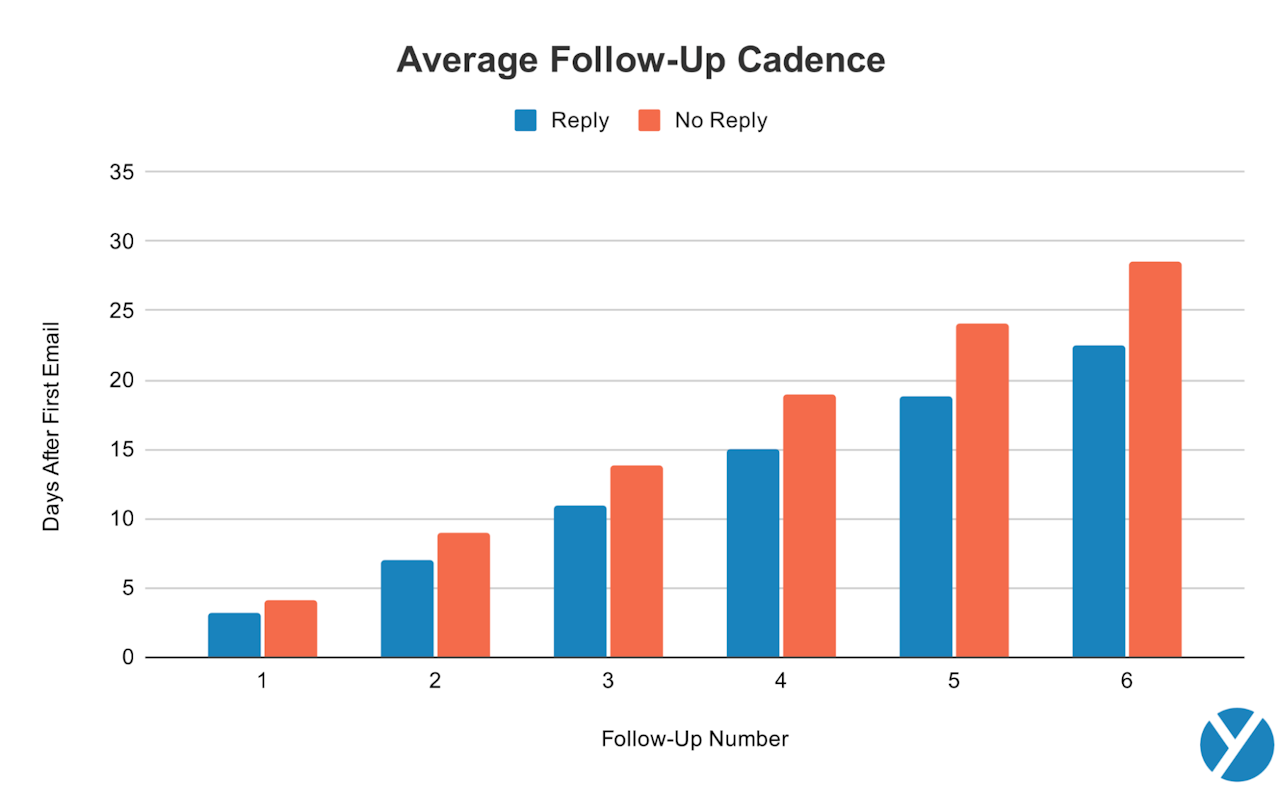
The chart above indicates that the best timing between touches is:
- First follow-up: 3 days
- Second follow-up: 7 days
- Third follow-up: 11 days
- Fourth follow-up: 15 days
- Fifth follow-up: 19 days
- Sixth follow-up: 22 days
Email automation tools can help you time your follow-up emails perfectly so that you’re never too early or too late.
Leveraging Sales Technology to Master the Soft Sell
In the realm of soft selling, where genuine connection and subtle persuasion are paramount, technology isn’t a distraction—it’s a powerful enabler. Far from making sales impersonal, the right tools allow sales professionals to maintain a high-touch, relationship-focused approach at scale, ensuring no detail is missed and every interaction adds value.
Here’s how strategic use of sales technology empowers you to master the soft sell:
CRM Systems: The Foundation for Personalized Soft Touches
Your Customer Relationship Management (CRM) system is the bedrock of effective soft selling. It’s much more than just a contact list; it’s a living repository of every interaction, preference, and historical detail about your prospects and customers.

- Centralized Relationship Data: A robust CRM captures every call, email, meeting note, past purchase, and even personal details (like a shared interest or a family update mentioned in a casual conversation). This comprehensive view ensures that every “soft touch” is informed, relevant, and genuinely personalized, making the prospect feel truly known and valued.
- Historical Context for Continuity: With a CRM, you can pick up any conversation exactly where it left off, regardless of who last spoke to the client. This seamless continuity builds trust and avoids repetitive questioning, reinforcing your commitment to their unique journey.
- Preference Tracking for Nuance: Record specific communication preferences, preferred content types, or even sensitive topics to avoid. This attention to detail, facilitated by your CRM, is a hallmark of truly soft and respectful selling.
Sales Engagement Platforms (SEPs) like Yesware!: High-Touch Outreach at Scale
Sales Engagement Platforms (SEPs) are specifically designed to bridge the gap between personalization and productivity, making them indispensable for mastering the soft sell without sacrificing efficiency. Yesware, in particular, empowers reps to maintain a low-pressure, relationship-focused approach even across a large pipeline.
- Personalized Outreach at Scale: Yesware allows you to create highly personalized email templates and multi-channel sequences. Instead of generic blasts, you can use dynamic fields, custom snippets, and conditional logic to ensure each message feels unique and relevant to the individual recipient. This enables consistent, non-pushy communication that resonates on a personal level, a cornerstone of the soft sell.

- Intelligent Follow-Up: Strategic, timely follow-up is vital in soft selling, but manual management is a huge drain. Yesware automates reminders and scheduling for your outreach across email, phone, and social channels. This ensures you maintain a consistent, value-driven cadence without being aggressive or overwhelming, allowing prospects the space they need while keeping the conversation moving.

- Engagement Insights: Yesware’s tracking capabilities provide invaluable data on how prospects interact with your communications. You can see email opens, link clicks, attachment views, and even reply rates. These insights are critical for a soft sell approach because they allow you to:
- Gauge Interest: Know when a prospect is engaged and ready for the next gentle nudge.
- Optimize Timing: Understand the best times to reach out based on their activity patterns.
- Adapt Tactics: If a particular piece of content isn’t getting traction, Yesware’s analytics help you identify it, allowing you to step back, pivot your message, or try a different approach. This prevents you from being overly persistent when a soft touch isn’t resonating.
![]()
Conversation Intelligence/AI: Refining Your Soft Sell Skills
AI-powered conversation intelligence tools are revolutionizing how sales professionals learn and execute the nuanced skills required for effective soft selling.
- Analyzing Soft Skills: These platforms record, transcribe, and analyze sales calls, providing objective feedback on elements crucial to soft selling, such as talk-to-listen ratio, empathy demonstrated, the quality of open-ended questions asked, and tone of voice.
- Coaching for Better Listening and Empathy: AI can highlight missed opportunities for deeper discovery or suggest alternative phrasing to build more rapport. This data-driven coaching accelerates the development of critical soft-selling skills.
- Identifying Nuanced Cues: AI can help identify subtle verbal and non-verbal cues that indicate a prospect’s comfort level, interest, or unspoken concerns, allowing reps to adjust their approach for maximum effectiveness.
In essence, sales technology doesn’t just make you more efficient; it makes you a better soft seller. It provides the data, insights, and capacity to deliver personalized, value-driven interactions at a scale that would be impossible manually, ensuring your soft sell approach is consistently effective and truly impactful.
Master the Soft Sell for Enduring Success
The shift towards a soft sell approach isn’t merely a fleeting trend; it’s a fundamental recognition that genuine connection, deep understanding, and consistent value delivery are the true drivers of modern sales success. By prioritizing empathy, trust, and long-term relationships over aggressive tactics, sales professionals can unlock unprecedented levels of customer loyalty, organic growth, and sustainable profitability.
The most effective soft sell strategies are those that are not only thoughtfully crafted but also intelligently executed and continuously refined. This is where the power of modern sales technology becomes indispensable.
A sophisticated Sales Engagement Platform (SEP) like Yesware doesn’t just automate tasks; it empowers you to elevate your soft sell approach to an art form. It provides the essential tools to:
- Personalize interactions at scale, ensuring every touch feels authentic and relevant.
- Maintain consistent, value-driven follow-ups, nurturing relationships without pressure.
- Gain crucial insights into prospect engagement, allowing you to adapt your approach with precision.
- Free up your valuable time from administrative burdens, so you can focus on the truly human aspects of building trust and rapport.
Ready to transform your sales strategy, build stronger customer bonds, and secure a future of consistent growth?
Discover how Yesware can empower you to master the soft sell approach and achieve remarkable results. Try Yesware for free today and experience the difference of truly high-touch selling, at scale.
Frequently Asked Questions About the Soft Sell Approach
Q1: What is the core difference between a soft sell and a hard sell?
The core difference lies in their approach to the buyer and the sales goal. A soft sell is a low-pressure, empathetic, and relationship-focused approach that prioritizes understanding the customer’s needs and building trust over time. Its goal is long-term partnership. A hard sell, conversely, is a direct, aggressive, and high-pressure method focused on closing a deal quickly, often using urgency or strong persuasion tactics, with a primary goal of a single, immediate transaction.
Q2: Why is the soft sell approach becoming more popular in today’s market?
The soft sell is gaining popularity because today’s buyers are more informed and less receptive to traditional aggressive tactics. With easy access to information online, buyers prefer to be educated and advised rather than pushed. The market has shifted towards valuing genuine trust, transparency, and long-term relationships, especially for complex or high-value products and services.
Q3: What are the main advantages of using a soft sell approach?
The key advantages of the soft sell include:
- Building Lasting Relationships: Fosters deep trust and rapport with customers.
- Increased Customer Loyalty & Retention: Leads to repeat business and reduced churn.
- Higher Customer Lifetime Value (CLTV): Loyal customers spend more over time.
- More Referrals: Satisfied clients become advocates for your business.
- Positive Brand Image: Cultivates a reputation for being customer-centric and trustworthy.
- Better suited for complex sales: Allows for thorough education and understanding of nuanced needs.
Q4: Are there any disadvantages or situations where the soft sell isn’t ideal?
Yes, while powerful, the soft sell isn’t always the perfect fit:
- Time-Consuming: It typically involves a longer sales cycle and requires more patience.
- Requires Skill: Demands strong active listening, empathy, and subtle communication skills.
- Risk of Passivity: If not executed correctly, it can be too subtle, potentially leading to missed opportunities if clear calls to action are avoided.
- Not Ideal for All Scenarios: It’s less effective for highly transactional, low-value, or urgent sales (e.g., a limited-time flash sale on a commodity product).
Q5: How does technology support sales professionals in mastering the soft sell?
Technology is crucial for executing a soft sell effectively and at scale:
- CRM Systems: Centralize customer history, preferences, and communication logs, enabling personalized interactions.
- Sales Engagement Platforms (SEPs): Tools like Yesware allow for personalized outreach, intelligent follow-ups, and provide engagement insights (opens, clicks) to gauge interest without being pushy.
- Conversation Intelligence/AI: Analyze sales calls to help reps refine active listening, empathy, and questioning skills.
- Automation: Frees up reps from administrative tasks, allowing them more time for high-value, relationship-building interactions.
Q6: Can the soft sell and hard sell approaches ever be blended?
Yes, the most skilled sales professionals often blend elements of both approaches. While the foundation of your strategy might be soft selling (especially for complex deals), you might incorporate a more direct “call to action” when the prospect has clearly demonstrated readiness, or subtly introduce urgency if a genuine time-sensitive offer is relevant. The key is to adapt your approach based on the specific customer, the stage of the sales cycle, and the situation’s nuances, always maintaining trust and transparency.
This article was updated on June 18th, 2025, to include the latest information and insights.
Get sales tips and strategies delivered straight to your inbox.
Yesware will help you generate more sales right from your inbox. Try our Outlook add-on or Gmail Chrome extension for free, forever!
Related Articles
Casey O'Connor
Casey O'Connor
Anya Vitko
Sales, deal management, and communication tips for your inbox
![How to Master the Soft Sell [Techniques + Examples]](/blog/_next/image/?url=https%3A%2F%2Fwww.yesware.com%2Fwp-content%2Fuploads%2F2023%2F08%2Fsoft-sell-yesware.jpg&w=1984&q=75)
